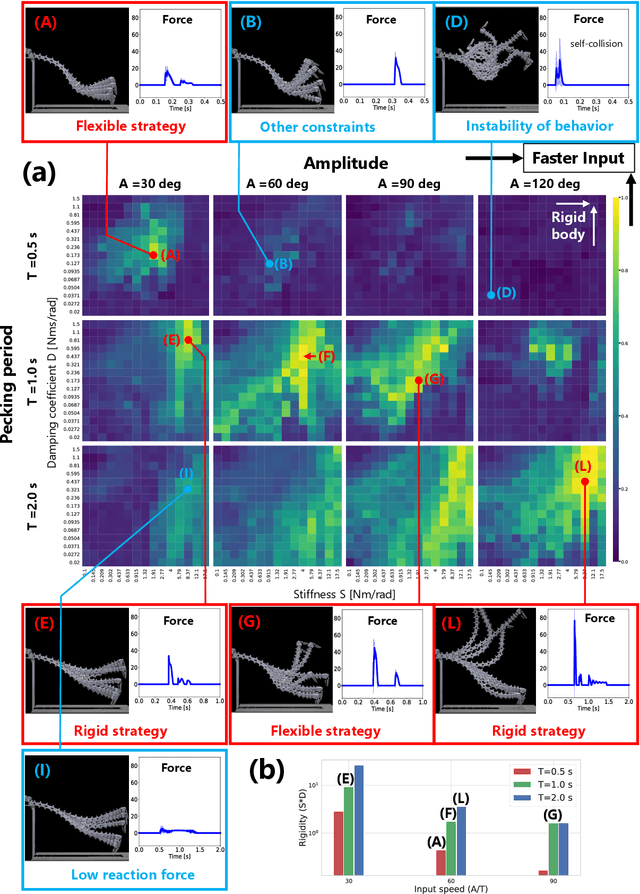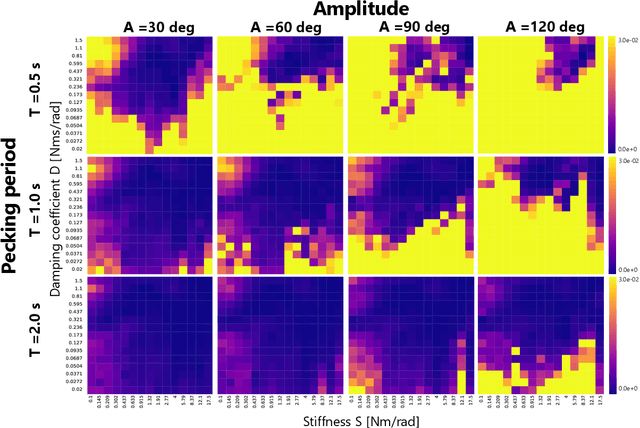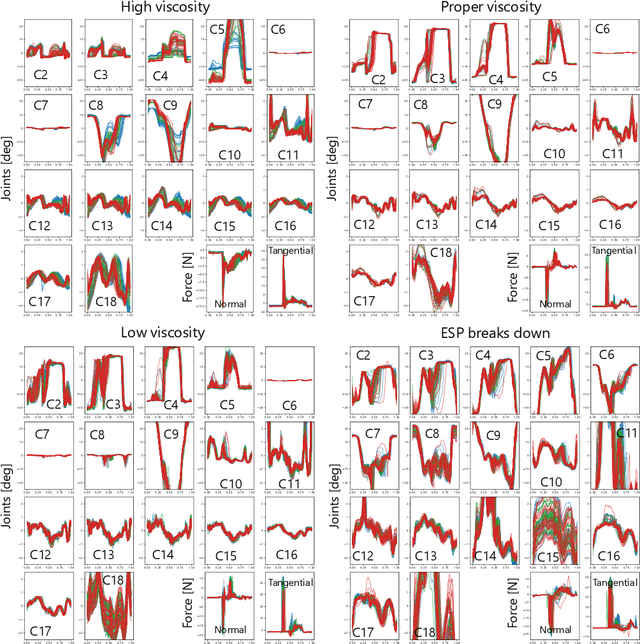Yasuo Kuniyoshi
Memory Determines Learning Direction: A Theory of Gradient-Based Optimization in State Space Models
Oct 01, 2025Abstract:State space models (SSMs) have gained attention by showing potential to outperform Transformers. However, previous studies have not sufficiently addressed the mechanisms underlying their high performance owing to a lack of theoretical explanation of SSMs' learning dynamics. In this study, we provide such an explanation and propose an improved training strategy. The memory capacity of SSMs can be evaluated by examining how input time series are stored in their current state. Such an examination reveals a tradeoff between memory accuracy and length, as well as the theoretical equivalence between the structured state space sequence model (S4) and a simplified S4 with diagonal recurrent weights. This theoretical foundation allows us to elucidate the learning dynamics, proving the importance of initial parameters. Our analytical results suggest that successful learning requires the initial memory structure to be the longest possible even if memory accuracy may deteriorate or the gradient lose the teacher information. Experiments on tasks requiring long memory confirmed that extending memory is difficult, emphasizing the importance of initialization. Furthermore, we found that fixing recurrent weights can be more advantageous than adapting them because it achieves comparable or even higher performance with faster convergence. Our results provide a new theoretical foundation for SSMs and potentially offer a novel optimization strategy.
Synaptic bundle theory for spike-driven sensor-motor system: More than eight independent synaptic bundles collapse reward-STDP learning
Aug 20, 2025Abstract:Neuronal spikes directly drive muscles and endow animals with agile movements, but applying the spike-based control signals to actuators in artificial sensor-motor systems inevitably causes a collapse of learning. We developed a system that can vary \emph{the number of independent synaptic bundles} in sensor-to-motor connections. This paper demonstrates the following four findings: (i) Learning collapses once the number of motor neurons or the number of independent synaptic bundles exceeds a critical limit. (ii) The probability of learning failure is increased by a smaller number of motor neurons, while (iii) if learning succeeds, a smaller number of motor neurons leads to faster learning. (iv) The number of weight updates that move in the opposite direction of the optimal weight can quantitatively explain these results. The functions of spikes remain largely unknown. Identifying the parameter range in which learning systems using spikes can be constructed will make it possible to study the functions of spikes that were previously inaccessible due to the difficulty of learning.
Feature-Based Lie Group Transformer for Real-World Applications
Jun 06, 2025Abstract:The main goal of representation learning is to acquire meaningful representations from real-world sensory inputs without supervision. Representation learning explains some aspects of human development. Various neural network (NN) models have been proposed that acquire empirically good representations. However, the formulation of a good representation has not been established. We recently proposed a method for categorizing changes between a pair of sensory inputs. A unique feature of this approach is that transformations between two sensory inputs are learned to satisfy algebraic structural constraints. Conventional representation learning often assumes that disentangled independent feature axes is a good representation; however, we found that such a representation cannot account for conditional independence. To overcome this problem, we proposed a new method using group decomposition in Galois algebra theory. Although this method is promising for defining a more general representation, it assumes pixel-to-pixel translation without feature extraction, and can only process low-resolution images with no background, which prevents real-world application. In this study, we provide a simple method to apply our group decomposition theory to a more realistic scenario by combining feature extraction and object segmentation. We replace pixel translation with feature translation and formulate object segmentation as grouping features under the same transformation. We validated the proposed method on a practical dataset containing both real-world object and background. We believe that our model will lead to a better understanding of human development of object recognition in the real world.
Emergence of Fixational and Saccadic Movements in a Multi-Level Recurrent Attention Model for Vision
May 19, 2025Abstract:Inspired by foveal vision, hard attention models promise interpretability and parameter economy. However, existing models like the Recurrent Model of Visual Attention (RAM) and Deep Recurrent Attention Model (DRAM) failed to model the hierarchy of human vision system, that compromise on the visual exploration dynamics. As a result, they tend to produce attention that are either overly fixational or excessively saccadic, diverging from human eye movement behavior. In this paper, we propose a Multi-Level Recurrent Attention Model (MRAM), a novel hard attention framework that explicitly models the neural hierarchy of human visual processing. By decoupling the function of glimpse location generation and task execution in two recurrent layers, MRAM emergent a balanced behavior between fixation and saccadic movement. Our results show that MRAM not only achieves more human-like attention dynamics, but also consistently outperforms CNN, RAM and DRAM baselines on standard image classification benchmarks.
Attractor-merging Crises and Intermittency in Reservoir Computing
Apr 17, 2025Abstract:Reservoir computing can embed attractors into random neural networks (RNNs), generating a ``mirror'' of a target attractor because of its inherent symmetrical constraints. In these RNNs, we report that an attractor-merging crisis accompanied by intermittency emerges simply by adjusting the global parameter. We further reveal its underlying mechanism through a detailed analysis of the phase-space structure and demonstrate that this bifurcation scenario is intrinsic to a general class of RNNs, independent of training data.
Emergence of Goal-Directed Behaviors via Active Inference with Self-Prior
Apr 15, 2025Abstract:Infants often exhibit goal-directed behaviors, such as reaching for a sensory stimulus, even when no external reward criterion is provided. These intrinsically motivated behaviors facilitate spontaneous exploration and learning of the body and environment during early developmental stages. Although computational modeling can offer insight into the mechanisms underlying such behaviors, many existing studies on intrinsic motivation focus primarily on how exploration contributes to acquiring external rewards. In this paper, we propose a novel density model for an agent's own multimodal sensory experiences, called the "self-prior," and investigate whether it can autonomously induce goal-directed behavior. Integrated within an active inference framework based on the free energy principle, the self-prior generates behavioral references purely from an intrinsic process that minimizes mismatches between average past sensory experiences and current observations. This mechanism is also analogous to the acquisition and utilization of a body schema through continuous interaction with the environment. We examine this approach in a simulated environment and confirm that the agent spontaneously reaches toward a tactile stimulus. Our study implements intrinsically motivated behavior shaped by the agent's own sensory experiences, demonstrating the spontaneous emergence of intentional behavior during early development.
Haptic Perception via the Dynamics of Flexible Body Inspired by an Ostrich's Neck
Apr 12, 2025



Abstract:In biological systems, haptic perception is achieved through both flexible skin and flexible body. In fully soft robots, the fragility of their bodies and the time delays in sensory processing pose significant challenges. The musculoskeletal system possesses both the deformability inherent in soft materials and the durability of rigid-body robots. Additionally, by outsourcing part of the intelligent information processing to the morphology of the musculoskeletal system, applications for dynamic tasks are expected. This study focuses on the pecking movements of birds, which achieve precise haptic perception through the musculoskeletal system of their flexible neck. Physical reservoir computing is applied to flexible structures inspired by an ostrich neck to analyze the relationship between haptic perception and physical characteristics. Combined experiments using both an actual robot and simulations demonstrate that, under appropriate body viscoelasticity, the flexible structure can distinguish objects of varying softness and memorize this information as behaviors. Drawing on these findings and anatomical insights from the ostrich neck, a haptic sensing system is proposed that possesses separability and this behavioral memory in flexible structures, enabling rapid learning and real-time inference. The results demonstrate that through the dynamics of flexible structures, diverse functions can emerge beyond their original design as manipulators.
Learning Conditionally Independent Transformations using Normal Subgroups in Group Theory
Apr 06, 2025Abstract:Humans develop certain cognitive abilities to recognize objects and their transformations without explicit supervision, highlighting the importance of unsupervised representation learning. A fundamental challenge in unsupervised representation learning is to separate different transformations in learned feature representations. Although algebraic approaches have been explored, a comprehensive theoretical framework remains underdeveloped. Existing methods decompose transformations based on algebraic independence, but these methods primarily focus on commutative transformations and do not extend to cases where transformations are conditionally independent but noncommutative. To extend current representation learning frameworks, we draw inspiration from Galois theory, where the decomposition of groups through normal subgroups provides an approach for the analysis of structured transformations. Normal subgroups naturally extend commutativity under certain conditions and offer a foundation for the categorization of transformations, even when they do not commute. In this paper, we propose a novel approach that leverages normal subgroups to enable the separation of conditionally independent transformations, even in the absence of commutativity. Through experiments on geometric transformations in images, we show that our method successfully categorizes conditionally independent transformations, such as rotation and translation, in an unsupervised manner, suggesting a close link between group decomposition via normal subgroups and transformation categorization in representation learning.
Enhancing Reusability of Learned Skills for Robot Manipulation via Gaze and Bottleneck
Feb 26, 2025Abstract:Autonomous agents capable of diverse object manipulations should be able to acquire a wide range of manipulation skills with high reusability. Although advances in deep learning have made it increasingly feasible to replicate the dexterity of human teleoperation in robots, generalizing these acquired skills to previously unseen scenarios remains a significant challenge. In this study, we propose a novel algorithm, Gaze-based Bottleneck-aware Robot Manipulation (GazeBot), which enables high reusability of the learned motions even when the object positions and end-effector poses differ from those in the provided demonstrations. By leveraging gaze information and motion bottlenecks, both crucial features for object manipulation, GazeBot achieves high generalization performance compared with state-of-the-art imitation learning methods, without sacrificing its dexterity and reactivity. Furthermore, the training process of GazeBot is entirely data-driven once a demonstration dataset with gaze data is provided. Videos and code are available at https://crumbyrobotics.github.io/gazebot.
Unsupervised categorization of similarity measures
Feb 12, 2025Abstract:In general, objects can be distinguished on the basis of their features, such as color or shape. In particular, it is assumed that similarity judgments about such features can be processed independently in different metric spaces. However, the unsupervised categorization mechanism of metric spaces corresponding to object features remains unknown. Here, we show that the artificial neural network system can autonomously categorize metric spaces through representation learning to satisfy the algebraic independence between neural networks, and project sensory information onto multiple high-dimensional metric spaces to independently evaluate the differences and similarities between features. Conventional methods often constrain the axes of the latent space to be mutually independent or orthogonal. However, the independent axes are not suitable for categorizing metric spaces. High-dimensional metric spaces that are independent of each other are not uniquely determined by the mutually independent axes, because any combination of independent axes can form mutually independent spaces. In other words, the mutually independent axes cannot be used to naturally categorize different feature spaces, such as color space and shape space. Therefore, constraining the axes to be mutually independent makes it difficult to categorize high-dimensional metric spaces. To overcome this problem, we developed a method to constrain only the spaces to be mutually independent and not the composed axes to be independent. Our theory provides general conditions for the unsupervised categorization of independent metric spaces, thus advancing the mathematical theory of functional differentiation of neural networks.
 Add to Chrome
Add to Chrome Add to Firefox
Add to Firefox Add to Edge
Add to Edge